七年级上册东北育才双语学校英语导学案
- 格式:xlsx
- 大小:162.76 KB
- 文档页数:6
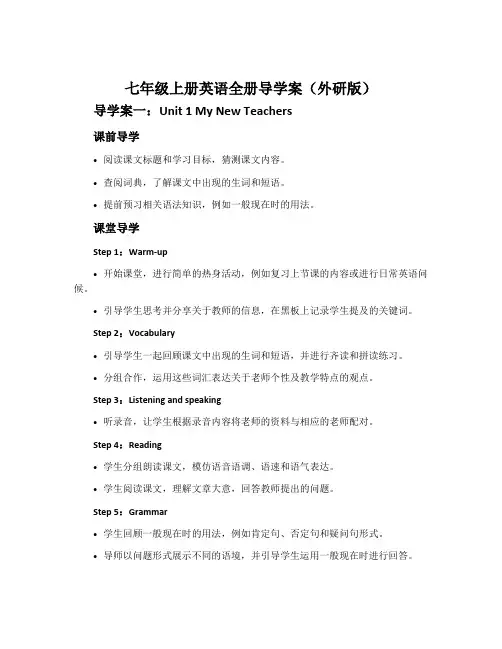
七年级上册英语全册导学案(外研版)导学案一:Unit 1 My New Teachers课前导学•阅读课文标题和学习目标,猜测课文内容。
•查阅词典,了解课文中出现的生词和短语。
•提前预习相关语法知识,例如一般现在时的用法。
课堂导学Step 1:Warm-up•开始课堂,进行简单的热身活动,例如复习上节课的内容或进行日常英语问候。
•引导学生思考并分享关于教师的信息,在黑板上记录学生提及的关键词。
Step 2:Vocabulary•引导学生一起回顾课文中出现的生词和短语,并进行齐读和拼读练习。
•分组合作,运用这些词汇表达关于老师个性及教学特点的观点。
Step 3:Listening and speaking•听录音,让学生根据录音内容将老师的资料与相应的老师配对。
Step 4:Reading•学生分组朗读课文,模仿语音语调、语速和语气表达。
•学生阅读课文,理解文章大意,回答教师提出的问题。
Step 5:Grammar•学生回顾一般现在时的用法,例如肯定句、否定句和疑问句形式。
•导师以问题形式展示不同的语境,并引导学生运用一般现在时进行回答。
•学生根据听到的内容,用一般现在时描述他们的英语老师或其他老师。
•学生交换作业,互相评价并提供建议改进。
课后导学•阅读课文,总结文章主题和关键信息。
•复习并熟记课文中的生词和短语。
•阅读相关阅读材料或小说,加强对一般现在时的理解和运用。
导学案二:Unit 2 This is my sister课前导学•阅读课文标题和学习目标,猜测课文内容。
•查阅词典,了解课文中出现的生词和短语。
•提前预习相关语法知识,例如单数名词的词尾变化。
课堂导学Step 1:Warm-up•进行简单的热身活动,例如复习上节课的句型或进行词汇游戏。
•让学生观察教室中的物品,并用英语描述。
Step 2:Vocabulary•回顾并巩固上节课学习的生词和短语。
•学生分组合作,运用这些词汇描述自己的家庭成员。
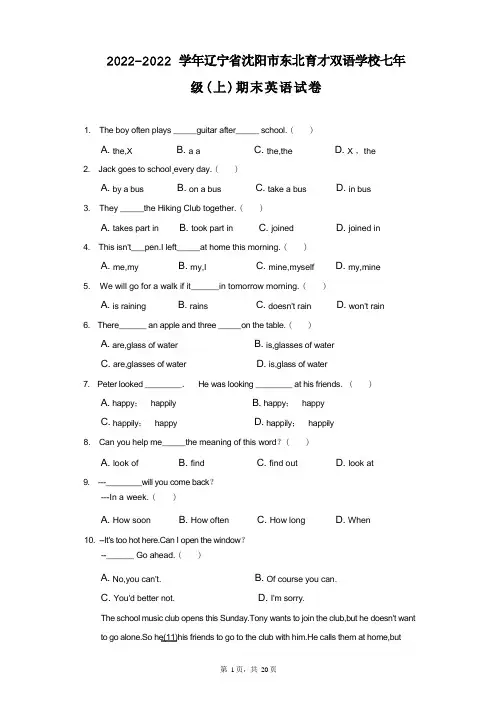
1. The boy often plays _____guitar after_____ school. ( )A. the,XB. a aC. the,theD. X ,the2. Jack goes to school every day. ( )A. by a busB. on a busC. take a busD. in bus3. They _____the Hiking Club together. ( )A. takes part inB. took part inC. joinedD. joined in4. This isn't___pen.I left_____at home this morning. ( )A. me,myB. my,IC. mine,myselfD. my,mine5. We will go for a walk if it______in tomorrow morning. ( )A. is rainingB. rainsC. doesn't rainD. won't rain6. There______ an apple and three _____on the table. ( )A. are,glass of waterB. is,glasses of waterC. are,glasses of waterD. is,glass of water7. Peter looked ________.He was looking ________ at his friends.( )A. happy;happilyB. happy;happyC. happily;happyD. happily;happily8. Can you help me_____the meaning of this word?( )A. look ofB. findC. find outD. look at9. ---________will you come back?---In a week. ( )A. How soonB. How oftenC. How longD. When10. --It's too hot here.Can I open the window?--______ Go ahead. ( )A. No,you can't.B. Of course you can.C. You'd better not.D. I'm sorry.The school music club opens this Sunday.Tony wants to join the club,but he doesn't want to go alone.So he(11)his friends to go to the club with him.He calls them at home,buteveryone is(12).Martin is doing his homework at home.It usually (13) him two hours to finish his homework. (14) is Peter doing?He is writing an e-mail on the computer to his pen friend Gina.She is a girl from America.He is(15)her about his school life.Lily likes(16) very much.Miss Green is teaching her and her classmates some English songs at school.Alice is having her twelfth birthday party.Her parents are making dinner(17) her in the kitchen.She is dancing to music with her friends in the living room.How about Kate?She is(18)her brother with his English.He doesn't do well in his English test.And Tom is shopping with his mother in the(19).They need to(20) some fruit andvegetables for the next week.Tony is not happy because no one can go to the club with him.11. A. helps B. tells C. asks D. speaks12. A. shy B. busy C. lazy D. afraid13. A. runs B. studies C. saves D. takes14. A. How B. When C. What D. Where15. A. saying B. speaking C. talking D. telling16. A. singing B. reading C. swimming D. drawing17. A. with B. about C. for D. from18. A. listening B. keeping C. practicing D. helping19. A. zoo B. library C. supermarket D. bookstoreD. bring20. A. sell B. buy C. takeLI'm David.Today is December 20th.It's my sister Jane's twelfth birthday.In the morning,my parents take us to Lucky Clothes Store first.There my mother buys a red sweater for Jane and a blue jacket for me.Then we go to Green Bookstore.There I buy an art book for Jane.In another store,my father buys a basketball for her.Jane likes playing basketball with my father after school.In the afternoon,my parents have a birthday party for Jane at home.Jane's friends,Nick and Anna,come to the party.Nick gives (送给) Jane a new pencil box.Anna gives her adictionary.Jane likes them very much.We play games and eat fruit at the party.We are very happy today.21. David is Jane's ______ .A. fatherB. uncleC. brotherD. friend22. Jane's mother buys her ______ .A. a red skirtB. a red sweaterC. a blue jacketD. a blue T-shirt23. Who gives Jane a dictionary?______A. Her father.B. Her brother.C. Nick.D. Anna.24. Which of the following is TRUE?______A. Jane can play basketball.B. David buys Jane a pencil box.C. Nick and Anna are Jane's cousins.D. The birthday party is on December 21st.MMany people like to travel by plane,but I don't like it because an airport(机场) is usually far from the city.You have to get there early and wait for hours for the plane to take off and it is often late.You can't open the windows.You can't choose the food.Planes are fast,but it takes hours to go out of the airport and into the city.I like traveling by train.I think trains are safe.Railway stations are usual in cities.Whenyou are late for a train,you can catch another one.You can walk around in the train and open the windows.You can see many interesting things on your way.I know it takes a little more time.I also like cars.You can start your journey when you want to,and you don't need to get to arailway station or a bus stop.Also you can carry many things with you in a car.But sometimes there are too many cars on the road.25. Why do many people like to travel by plane?______A. Because it is safe.B. Because it is fast.C. Because you can walk around in the plane.D. Because it is cheap.26. Which is NOT the good thing about the train?______A. It is safe.B. You can walk around in the train.C. You can open the windows.D. It takes a little more time.27. What is the bad thing about the car?______A. You needn't go to a station.B. You can start your journey when you want to.C. There are too many cars on the road sometimes.D. You needn't go to a bus stop.28. What does the writer think of the plane,train and car?______A. He thinks it takes a lot of time to go to and get out of the airport.B. He likes to take a train because it takes a little more time.C. He likes to take a car because he has a car.D. He likes to take a plane because it's fast.NAnimals are important to us and they are our friends.But some of them are in great danger now.What can we do to help save them?Don't eat wild animals meat.Some of us like to eat meat.But do you know some meat comes from endangered (濒危的) animals?To save animals,don't eat their meat.And it's healthy for us,too.Don't wear clothes made of fur(毛皮) .Sometimes people kill animals for fur.If we don't buy clothes made of fur,people will not kill animals.Please give away money to Animal Helpers.The group does everything to help save animals.But it often needs money.So save some money and give it away to the group to help animals.Tell people that it's important to save animals.Not all people know animals are our friends and that we must save them.So why not tell people around us that it's important to save animals?Do you have any other good ways to help save animals?Write to tell us.29. How many ways to save animals are there in the passage?______A. Three.B. Four.C. Five.D. Six.30. What can you do to help save animals if you have much money?______A. Get some meat to eat.B. Buy clothes made of fur.C. Give away some money.D. Keep some animals.31. Froth the passage,we CAN NOT know ______ .A. some animals around us are in great dangerB. some animals are not friendly to peopleC. Animal Helpers can help save animalsD. some of us don't know it's important to save animals32. What is the best title for the passage?______A. How to help save animals.B. What to do for Animal Helpers.C. When to help save animals.D. Where to find many animals.OA Trip to the ForestOne day,Bob and two of his friends went to the forest.They put up their tents(帐篷) and then rode off to the forest to see how the trees were growing.In the afternoon when they were about ten kilometers from their camp ,it started to snow.More and more snow fell.Soon Bob could hardly see his hands before his face.He could not find the road.Bob knew there were two roads. .One road led to the camp,and the other led to his house.But there was.White snow everywhere.Everything was the same.How could he and his friends go back to the camp?Bob had an idea.The horses!Let the horses take them back!It was getting late.They rode on and on.At last the horses stopped.Where were they?None of them could tell.Bob looked around.What was that under the tree?It was one of their tents!33. Bob and his two friends went to the forest to ______ .A. watch the trees in the forestB. build their campC. enjoy the mountains in the snowD. find their way home34. They could not find their way back because ______ .A. there was only one road to their campB. they couldn't decide which of the two roads led to the campC. there were no roads in the forest at allD. everything was covered with white snow35. Bob and his friends wanted the horses to take them to ______ .A. Bob's houseB. the campC. the forestD. the mountains36. At last,the horses stopped because ______ .A. it was getting lateB. they were tired after running a long wayC. they knew that they had got to the campD. they had seen Bob's houseA.I think you will love it too.B.Now let me tell you the time of animal shows in our zoo.C.The Monkey Show is one hour later.D.There are no other restaurants outside the zoo.E.What a fine trip it is!Hi,everyone!I am David.Welcome to our zoo.We have many kinds of animals here. (1) At ten o'clock in the morning,you can watch the Panda Show.Pandas are very cute,right?(2) It's from eleven o'clock to eleven thirty.I think many of you like monkeys.Afterthat,you can have lunch at the restaurant in our zoo. (3) At half past two in the afternoon,we have the Lion Show. (4) Then we have the Tiger Show at three o'clock and the Elephant Show at three thirty.My favorite animals are elephants,so the Elephant Show is my favorite.What animal show would you like to watch?Remember the time for the shows and have a good time here!37. A. A B. B C. C D. D E.E38. A. A B. B C. C D. D E.E39. A. A B. B C. C D. D E.E40. A. A B. B C. C D. D E.E41. If LA (Los Angeles 洛杉矶) is the movie center of the World,Universal Studio (环球影城) is the movie center of LA.They have many things for visitors.We took a train to goon a trip in the studio.We saw many famous characters(角色) in the movies there.It felt so real that I was even scared (胆怯的) when the 3 D monkey came for us.We also leanta lot about how Universal Studios made the movies there.When you are in LA,you must go to Disneyland.With lovely animals,exciting shows and fun buildings,Disney is the best place for children and their family.I tried many interesting rides there.The best part of the day was the Aladdin show.It's about the story of the young man Aladdin who got a magic lamp to help him realize his dream.Our last stop in LA is Kodak Theater.That's the place to have the Oscars (奥斯卡) .So there are many things about famous movie stars.It was exciting!At the end of the day,my mom sadly fell ill.So we spent the night at the hospital.Wecouldn't go on our trip,but I've seen the best of LA.It was a wonderful trip!(1) How did the author travel around the Universal Studios?______(2) What did the author see in the Universal Studios?______(3) What did the author like best about Disneyland?______(4) Where did the author stay on the last night in LA?______42. Newspapers are very important in our (1) (day) life.Many people begin their day byreading the paper.In this way they learn what is (2) ( go) on in theworld.Sometimes,however,they didn't have the time (3) ( read) the news carefully or they may be in such a hurry that they have time only to have a (4)( quickly) look at the headlines.There are newspapers to please every reader.In big cities there are many types with several different editions (版) every day.In some towns there (5) ( be) fewer newspapers and perhaps only one edition each day.In some places the paper is printed (印刷) weekly.Most (6) (paper) have several editions,especially on Sundays when the edition is (7) (large) than usual.There are,besides the front page with the most important news,the sports news,the amusement page,a business page and so on.(1)(2)(3)(4)(5)(6)(7)43. The Clubs FairLinda and Leo are new students at Rosie Bridge st month,they(A) went to the Clubs Fair.First,Linda and Leo learnt about the Rocket Club." (B) Our club will teach you how to build rockets. Then you can launch them into the sky",a boy said,"watch!" He took a rocket and launched it.The rocket disappeared into the sky.Linda and Leo were very (C) surprised."Will it go all the way into space?" Linda asked."Of course it won't" a girl from (D) _______club shouted."Our club is e and join the Solar Power Club.""What do you do?" asked Leo."We make wonderful machines.They only use solar power.Look!" She took a toy car from the table and the(nE ) 用远程遥控器驾驶它all around the playground."It uses power (F) ______the Sun,"said Linda."That's amazing!" After the fair,they felt very excited."I want to join all the clubs,saidLinda."Me too!said Leo.(1) 写出A 处和C 处的同义句或者近义词:______ ;______(2) 将B 处的句子改写为:Our club will teach you ______ ______ ______ build rockets.(3) 在D 处和F 处填入适当的词:______ ;______(4) 将E 处翻译成英语:______(5) 从文中找出文中俱乐部制作的两个物品:______ ;______44. Do you know anything about the way of shopping in western countries?People thereusually make a shopping list first and then they go shopping.Most people(A) like going to the supermarkets (B) ______they can get (C) almost everything in one supermarket.For example,many styles of clothes,food,sports thing...And the things in supermarkets are cheaper.When they get into the supermarket,they carry a basket.Then they buy things and put them(D) _____the basket. ( E) After they get everything they want,they pay the money. ( F) 大多数人一周去一次超市。
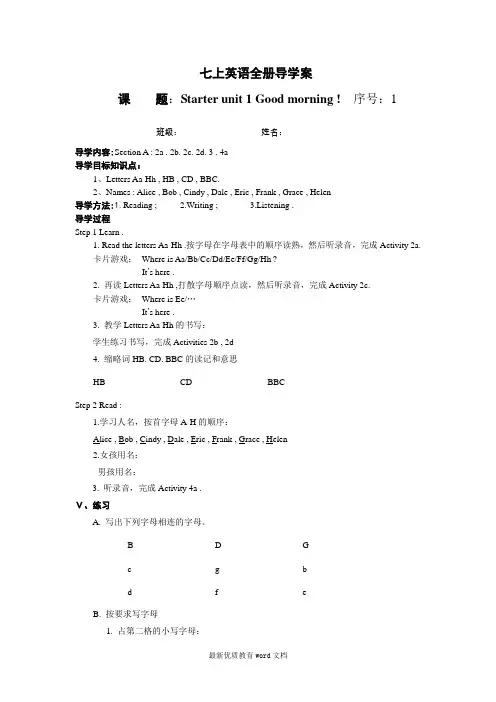
七上英语全册导学案课题:Starter unit 1 Good morning ! 序号:1班级:____________ 姓名:____________导学内容:Section A : 2a . 2b. 2c. 2d. 3 . 4a导学目标知识点:1、Letters Aa-Hh , HB , CD , BBC.2、Names : Alice , Bob , Cindy , Dale , Eric , Frank , Grace , Helen导学方法:1.Reading ; 2.Writing ; 3.Listening .导学过程Step 1 Learn .1. Read the letters Aa-Hh .按字母在字母表中的顺序读熟,然后听录音,完成Activity 2a.卡片游戏:- Where is Aa/Bb/Cc/Dd/Ee/Ff/Gg/Hh ?- It’s here .2. 再读Letters Aa-Hh ,打散字母顺序点读,然后听录音,完成Activity 2c.卡片游戏:- Where is Ee/…- It’s here .3. 教学Letters Aa-Hh的书写:学生练习书写,完成Activities 2b , 2d4. 缩略词HB. CD. BBC的读记和意思HB____________ CD____________ BBC____________Step 2 Read :1.学习人名,按首字母A-H的顺序:Alice , Bob , Cindy , Dale , Eric , Frank , Grace , Helen2.女孩用名:____________ ____________ ____________ ____________男孩用名:____________ ____________ ____________ ____________3. 听录音,完成Activity 4a .Ⅴ、练习A. 写出下列字母相连的字母。
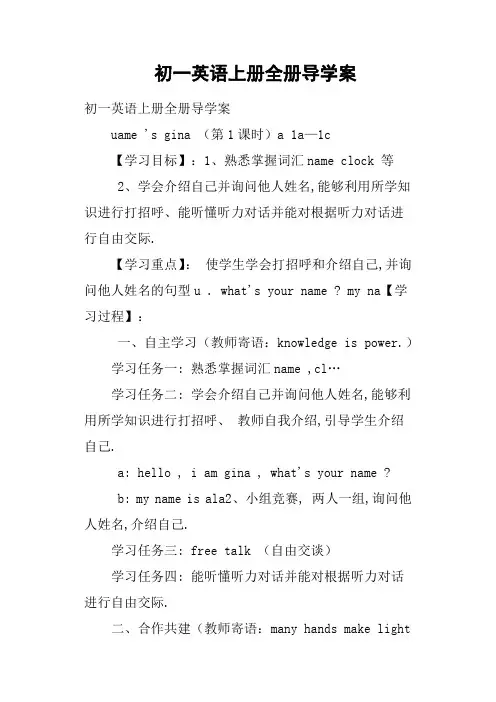
初一英语上册全册导学案初一英语上册全册导学案uame 's gina (第1课时)a 1a—1c【学习目标】:1、熟悉掌握词汇name clock 等2、学会介绍自己并询问他人姓名,能够利用所学知识进行打招呼、能听懂听力对话并能对根据听力对话进行自由交际.【学习重点】:使学生学会打招呼和介绍自己,并询问他人姓名的句型u . what's your name ? my na【学习过程】:一、自主学习(教师寄语:knowledge is power.)学习任务一: 熟悉掌握词汇name ,cl…学习任务二: 学会介绍自己并询问他人姓名,能够利用所学知识进行打招呼、教师自我介绍,引导学生介绍自己.a: hello , i am gina , what's your name ? b: my name is ala2、小组竞赛, 两人一组,询问他人姓名,介绍自己.学习任务三: free talk (自由交谈)学习任务四: 能听懂听力对话并能对根据听力对话进行自由交际.二、合作共建(教师寄语:many hands make lightwork. )小组讨论我们所学的英语名字和汉语名字的区别, 如何用英语拼写你的名字?三、系统总结(教师寄语:no man can do two things at once.)、归纳你所学到的问候语.2、自己编写一个打招呼并询问姓名的小对话.四、诊断评价(一)单项选择_______your name ? my name is gina .a. whatb. what'sc. whod. w2. good morningwang ! _____________!a. hello bu d. good morning_______sally , what______ your name ?a. am ,isb. is , ad.am, a______name is li la.i b. i ad. you5.— _______, what's your name ?— john ga. hi bd. excu(二)写出下列单词的完全形式, 并写出汉语意思.i'm _________ __________ what's __________________name 's ___________ __________(三)写出下列单词.时钟 _______ 我的 ________ 你的___________ 名字_______ 遇见_________(四)尝试翻译下列句子见到你很高兴._________________________________.2. 我叫王小雨.____________________________________你叫什么名字? ____________________________________(五)根据情景补全对话.a: good a!b: ____________________!a; i ______lucy . _________your name ?b: my ____________you !a: _______________________________.体验中考:单项选择't ______ walaa. my bd. you 2a student and name is kate. a. she bd五、拓展:中英互译黑色 ___________ 2. 红色___________ 3. 白色___________蓝色___________ 5. 绿色___________ 6. 橙色___________棕色___________ 8. 黄色___________ 9. basketball___________10. baseball___________ 11. clock___________ 12. cap ___________goldfish___________ 14.glasses___________ 15.dictionary___________backpack ___________ 17. window___________ 18. door ___________六【课后反思】(教师寄语:never do things by halves)uame 's gina.(第2课时)a (2a—2c)【学习目标】:1、熟练掌握本课时的单词.2、学会询问他人姓名及介绍他人姓名、能听懂有关谈论他人姓名的对话并进行自由交际.【学习重点】:询问他人姓名及介绍他人姓名的句型.一、自主学习(教师寄语:knowledge is power.)学习任务一: 1.小组合作,理解并熟读下列短语,并写出汉语意思.ame ( ) your name ( ) his name ( ) her name ( )2.复习上节课的内容运用句型:what's your / his / her name?/ his / her na进行自由交际.学习任务二: 听听力完成2a,2b.学习任务三: 对话练习(pairwork)二、系统总结(教师寄语:no man can do two things at once.)根据提示,完成下列问答._______ _______what's _______ name? ______________ ________ 语法重难点 1.形容词性物主代词-----起形容词作用,在句中只能作定语,也就是说它后面必须跟一个名词。
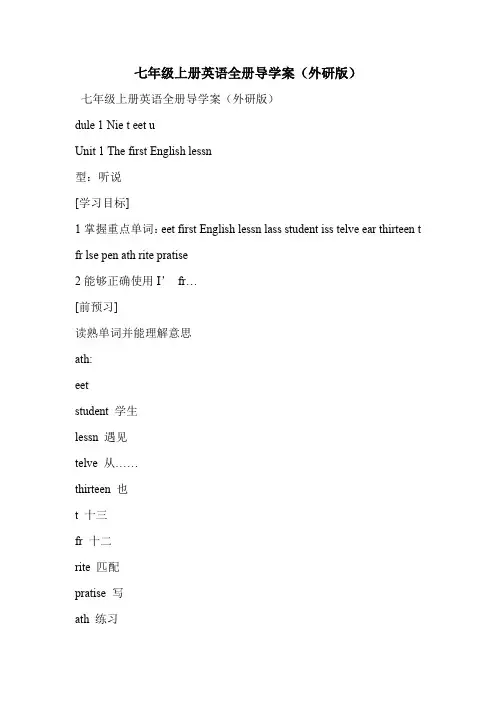
七年级上册英语全册导学案(外研版)七年级上册英语全册导学案(外研版)dule 1 Nie t eet uUnit 1 The first English lessn型:听说[学习目标]1掌握重点单词:eet first English lessn lass student iss telve ear thirteen t fr lse pen ath rite pratise2能够正确使用I’fr…[前预习]读熟单词并能理解意思ath:eetstudent 学生lessn 遇见telve 从……thirteen 也t 十三fr 十二rite 匹配pratise 写ath 练习[堂活动]Step 1检查1)Listen and he h an peple spea1 □2 □3 □2)L at the piture hih rds an u use t desribe the piture?hinese lass father friend ther shl student teaherStep 2 Listening1)Listen and he the true sentenes1iss Li is a teaher □2Lingling is fr Beiing □3 Daing and Lingling are friends □4 Daing and Lingling are English □ang Hui is telve ears ld □2)Listen and fill in the blansiss Li: Hell nae’s iss Li I’a teaher and I’hinese I’____ uhanhat’s ur nae? here are u fr?Lingling: nae’s Lingling I’fr Beiing I’_____ ears ld and I’hinese This is Daing He’s friend e’re studentsDaing: Hell nae’s Daing I’a _______and I’telve ears ld I’fr Beiing Lingling is friend hat’s ur nae?ang Hui: nae’s ang Hui I’______ears ld I’fr Shanghai and I’a student I’hinese I’in lass neiss li: Nie t_____ u, ang Huiang Hui: Nie t eet u, ______Step 3 Read quil and fill in the frNaeAgebituntriss LiLinglingDaingang HuiStep 4 Speaing1、r in pairs As and anserA: hat’s ur nae? B: nae’s…A: here are u fr? B: I’fr…A: Nie t eet u,… B: Nie t eet u ,t2、Intrdue urself t lass Using these ashinese nae is Ni Shihun English nae is harltte I’ an Eng lish teaheru an all e iss /s Ni I’ 39 ears ld I’ fr Beiing, hina I’ hinese I teah in Beiing N80 unir High Shl Gu’re students e’re gd friendsReeber these language pints:1)_ hinese / English nae is…2)_I’ a student 3)_I’ …ears ld 4)_I’ fr…)_I stud in … unir High Shl6)_e’re ur students7)_e’re gd friends, tStep Vabular and prnuniatin(Ativit 6,7,8)1、Listening and repeat (Ativit 6)1)Listen arefull 2)Repeat after the tape2、Listening and repeat (Ativit 7)First,read alud; Then,repeat after the tape总结s在单词末尾的读音。

Unit 1 This is me!【学习目标】1 学会简单地介绍自己。
2 能适时运用一些简单的问候语。
重点难点1、学会简单地介绍自己。
【导学提纲】预习P6-7页内容,完成下列练习。
一、翻译下列词组.1. 早上好 ___________________2. 晚安 ___________________________3. 我的名字是 _______________4. 下午好 ___________________________5. 我的主人 _________________6. 照顾你的弟弟 _____________________7. 第一天 ________________ 8. 见到你很高兴 _____________________二、根据不同时间写出正确的问候语9:30 __________________ 14:20 ______________________ 20:40 _________________ 睡觉前的问候语 ____________________三. 从右边一栏中选出与左栏相对应的句子。
( ) Are you Millie? A. Nice to meet you, too.( ) what’s your name? B. Good afternoon.( ) Nice to meet you. C. Daniel.( ) How are you? D. Yes, I am.( ) Good afternoon. E. Fine, thanks.【反馈矫正】一、单项选择( ) 1. Please _________ my grandmother. She is ill(生病) today.A. look forB. look afterC. look likeD. look at ( ) 2. This book is good. ______ this book, please.A. SeeB. Look atC. ReadD. Talk( ) 3. Excuse _______, are ________ my master?A. me, youB. my, yourC. I, youD. me, your( ) 4. I don’t know _________ kites. Can you help me?A. how flyB. how to flyC. what to flyD. what fly( ) 5. _________ talk in class.A. Please notB. Don’t pleaseC. Please don’tD. Not please二、句型转换(每空一词)1. I am Jill. (同义句) _______ ________ _______ Jill.2. His name is Tom (划线部分提问) ________ ________ _________?3. Please read this book. (否定句) Please _________ ________ this book.4. Please look after this dog. (同义句) Please _______ ______ _______ this dog.三、翻译句子(每空一词)1. 你叫什么名字?我是米莉。

Unit 1 A new start单元教学目标单元教材分析本单元的话题是“人与自我”下的“生活与学习”,归属于“多彩、安全、有意义的学校生活”这个主题。
本单元内容围绕探索初中学校生活展开,主要包括:描述开学第一天不同国家人们的行为;介绍开学第一课;谈论关于初中学校生活的计划;描述对初中生活的理解。
旨在让学生更好地适应初中生活。
课时分解第一课时Starting out&ReadingTeaching Objects【教学目标】1.Discuss the customs of the first school day in different countries.2. Understand a famous saying about learning.3. Talk about the first lesson in junior high.Teaching Aids【教学工具】an English book,a tape recorder and CAITeaching Steps【教学步骤】★Step 1Lead in【导入】T: September 1st is the first day of school in China. Most schools have special activities to celebrate this day. What activities do the schools have?Ss:For example, have the school opening ceremony, have the flag-raising ceremony, watch the program The First Lesson produced by CCTV, have some welcome performances.Starting outPage 15,11.Ask the Ss to discuss the question: What do people do on the first day of school inRussia/ Indonesia/ France/ the USA?2.Show the four sentences on page 15 to the Ss and make sure they understand the meaning of these sentences.3.Ask the Ss to guess and match the sentences with the countries.4.Check the answers with the class.Page 15,21.Ask the Ss to answer the question: What is junior high school life like?2.Let the Ss list something about what junior high school life is like.3.Ask the Ss to complete the table.Understanding ideas(1-4)★Step 2 Pre-task【准备任务】Page 16,11.Show the questionnaire to the Ss.2.Ask the Ss to answer the following questions.①What was your first lesson at junior high?②What did you do in that lesson?③What do you think is important in learning the lesson?3.Let the Ss complete the questionnaire.Page 16,2Ask the Ss to look at the picture and the title, and then ask them to discuss the following questions.①What was the writer’s first lesson at junior high?②What did the writer do in that lesson?★Step 3 While-task【过程任务】Page 16,21.Let the Ss read the passage and answer the question: What did the writer do in his first lesson?2.Ask some students to say their answers.3.Check the answers with the class.Page 18,31.Ask the Ss to read the passage again and choose the main idea of the passage.2.Check the right answer with the class.3.Tell the way to summarize the main idea of a passage.Page 18,41.Let the Ss complete the summary with the words and expressions from the passage.2.Ask some students to say their answers.3.Check the answers with the class.★Step 4 Post-task【后续任务】Page 18,Think and share1.Ask the Ss to think about the following question.What is the meaning of the sentence from Confucius?2.Give the Ss some prompts. For example, Who did Confucius say the sentenceto? Why did he say it? What do you think about learning and thinking?3.Choose some Ss to share their answers.4.Ask the Ss to think about the following question:Do you know other famous sayings about learning?5.Let some students share their answers.6.Make appropriate supplements according to students’ share.For example, thinking without studying is useless;Reading without understanding is like chewing bark;Skill comes from diligent practice, and neglect results come from idleness;A journey of a thousand miles begins with a single step.★Step 5Language points【语言要点】1. mistake的用法mistake 作名词,意为“错误;失误”。

七年级英语上册教案导学案全册(最新人教版)人教版七年级英语上册教案导学案全册本文档包含9个单元的教案导学案,每单元含说课,教学详案及设计,每个单元有四个课时同步练习,每单元末还有单元语法精讲Unit 1 My name‘s Gina.话题Topic功能Functions语法Grammar词汇和常用表达 Words & expressions学习策略 Strategies 文化知识Culture 三维目标 Three-dimensional target结交新朋友Making new friends 1.能够介绍自己的姓名Introduce yourself My name is…/I‘m…/My first/last name is… 2.能够简单地问候初结识的朋友Greet peopleHi!/Hello!/Good morning!/Nice to meet you!3.能够询问和告知电话号码Ask for and give telephone numbers A:What‘s your/his/her phone number? B:It‘s…一、能够正确使用 be动词的一般现在时的用法The simple present tense to be I‘m Gina./My name is Gina. A:Are you Tony? B:Yes,I am./No,I‘m not.二、能正确使用What引导的特殊疑问句询问对方姓名和电话号码(What questions)What‘s your name?What‘s your telephone number?三、能够正确使用下列形容词性物主代词Possessive pronounsmy,your,his,her1.能正确使用下列词汇Curriculum words(按词性排列) 名词:name,telephone,phone,number,friend,China,school;代词:your,her,his,he,she;形容词:nice,first,last,middle; 数词:zero,one,two,three,four,five,six,seven,eight,nine; 动词:meet;其他:too,not,and,yes,no,to,Ms. 2.能正确使用下列常用表达Useful expressionstelephone number,phone number,first name,last name,middle school Nice to meet you!1.初步学习在听力和阅读过程中把握具体的信息2.懂得常见英语人名和电话号码 1.了解英语姓名小常识 2.了解西方初次见面的礼节1.能掌握以下单知识与词:name,nice,to,meet,too,your,Ms.,his,and,her,yes,she,he,no, 技能not,zero,one,two,three,four,five,six,seven,eight,nine,telephone,number,phone,first,last,friend,China,middle,school 2.熟练掌握单元短语: telephone number/phone number,firstname,last name,middle school,in China 3.能掌握以下句型: My name‘s Gina.A:What‘s your/his/her/name?B:(I‘m)Alan./He‘s Eric./His name‘s Eric./She‘s Mary./Her name‘s Mary.A:Hello,Alan.I‘m Ms.Brown.知识与技能B:Nice to meet you. A:Are you Helen?B:Yes,I am./No,I‘m not.I‘m Gina.4.了解以下语法:形容词性物主代词my,your,his,her的用法;be 动词的三维目标 Three-dimensional target一般现在时的用法:含am,are,is的肯定句、否定句和疑问句;What开头的询问姓名和电话号码的疑问句的构成和回答。
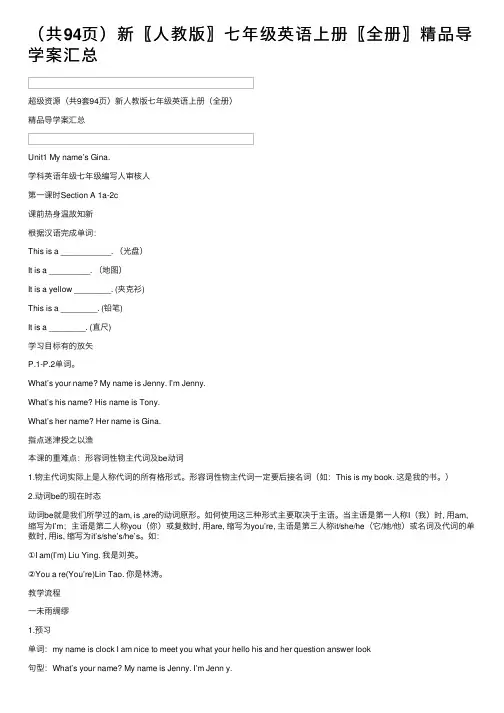
(共94页)新〖⼈教版〗七年级英语上册〖全册〗精品导学案汇总超级资源(共9套94页)新⼈教版七年级英语上册(全册)精品导学案汇总Unit1 My name’s Gina.学科英语年级七年级编写⼈审核⼈第⼀课时Section A 1a-2c课前热⾝温故知新根据汉语完成单词:This is a ___________. (光盘)It is a _________. (地图)It is a yellow ________. (夹克衫)This is a ________. (铅笔)It is a ________. (直尺)学习⽬标有的放⽮P.1-P.2单词。
What’s your name? My name is Jenny. I’m Jenny.What’s his name? His name is Tony.What’s her name? Her name is Gina.指点迷津授之以渔本课的重难点:形容词性物主代词及be动词1.物主代词实际上是⼈称代词的所有格形式。
形容词性物主代词⼀定要后接名词(如:This is my book. 这是我的书。
)2.动词be的现在时态动词be就是我们所学过的am, is ,are的动词原形。
如何使⽤这三种形式主要取决于主语。
当主语是第⼀⼈称I(我)时, ⽤am,缩写为I’m;主语是第⼆⼈称you(你)或复数时, ⽤are, 缩写为you’re, 主语是第三⼈称it/she/he(它/她/他)或名词及代词的单数时, ⽤is, 缩写为it’s/she’s/he’s。
如:①I am(I’m) Liu Ying. 我是刘英。
②You a re(You’re)Lin Tao. 你是林涛。
教学流程⼀未⾬绸缪1.预习What’s his name? His name is Tony.What’s her name? Her name is Gina.2.⼩试⽜⼑预习检测:⽤所给词的正确形式填空(1). W hat’s ______ (you) name?(2). ______(he) pen is black .(3).This is ______ (she) name.(4). He _____ (be) Tom.(5). I ___ (be) Miss Wang.(6). Tom and King _____(be) good friends.⼆课堂探究1.⾃主学习(1). I’m _____ (you) new English teacher.(2). ____ (he) i s a new student. What’s _____ (he) name?(3). ____ (I) am Jim. ____ (I)(4). What _____(be) your name?(5) _____(be) he Li Ming?2.合作探究(兵教兵) 完成对话(1)A: What’s ______ name?B: My name_____ Jenny.A: I_____Tony.B: Nice to meet ______.(2) A:Wha t’s his name?B: ____ name is Tony.A: And what’s ______name?B: Her name _____ Jenny.3.质疑解疑形容词性物主代词顺⼝溜我的my你的your, 我们的是our。
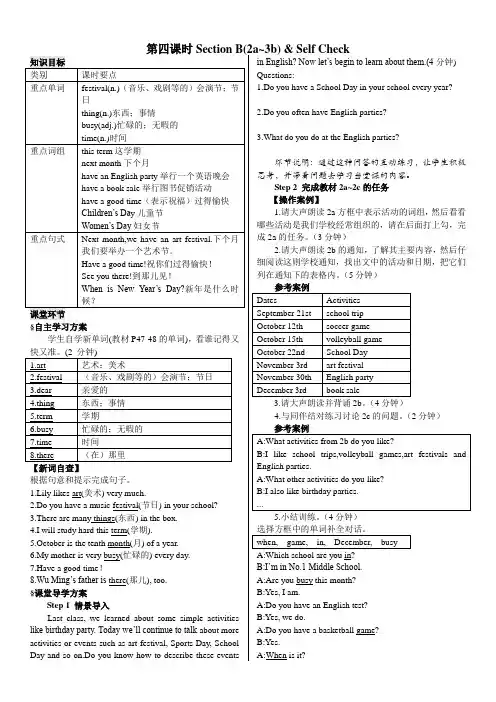
第四课时Section B(2a~3b) & Self Check知识目标类别课时要点重点单词festival(n.)(音乐、戏剧等的)会演节;节日thing(n.)东西;事情busy(adj.)忙碌的;无暇的time(n.)时间重点词组this term这学期next month下个月have an English party举行一个英语晚会have a book sale举行图书促销活动have a good time(表示祝福)过得愉快Children’s Da y儿童节Women’s Day妇女节重点句式Next month,we have an art festival.下个月我们要举办一个艺术节。
Have a good time!祝你们过得愉快!See you there!到那儿见!When is New Year’s Day?新年是什么时候?课堂环节§自主学习方案学生自学新单词(教材P47-48的单词),看谁记得又快又准。
(2 分钟)1.art 艺术;美术2.festival (音乐、戏剧等的)会演节;节日3.dear 亲爱的4.thing 东西;事情5.term 学期6.busy 忙碌的;无暇的7.time 时间8.there (在)那里【新词自查】根据句意和提示完成句子。
1.Lily likes art(美术) very much.2.Do you have a music festival(节日) in your school?3.There are many things(东西) in the box.4.I will study hard this term(学期).5.October is the tenth month(月) of a year.6.My mother is very busy(忙碌的) every day.7.Have a good time!8.Wu Ming’s father is there(那儿), too.§课堂导学方案Step 1 情景导入Last class, we learned about some simple activities like birthday party. Today we’ll continue to talk about more activities or events such as art festival, Sports Day, School Day and so on.Do you know how to describe these events in English? Now let’s begin to learn about them.(4分钟) Questions:1.Do you have a School Day in your school every year?_____________________________________2.Do you often have English parties?_____________________________________3.What do you do at the English parties?_____________________________________环节说明:通过这种问答的互动练习,让学生积极思考,并带着问题去学习当堂课的内容。
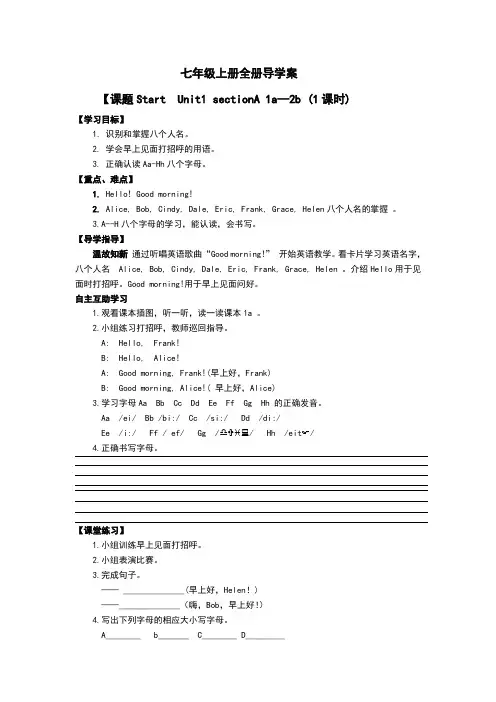
七年级上册全册导学案【课题Start Unit1 sectionA 1a—2b (1课时)【学习目标】1. 识别和掌握八个人名。
2. 学会早上见面打招呼的用语。
3. 正确认读Aa-Hh八个字母。
【重点、难点】1. Hello! Good morning!2. Alice, Bob, Cindy, Dale, Eric, Frank, Grace, Helen八个人名的掌握。
3.A--H八个字母的学习,能认读,会书写。
【导学指导】温故知新通过听唱英语歌曲“Good morning!”开始英语教学。
看卡片学习英语名字,八个人名 Alice, Bob, Cindy, Dale, Eric, Frank, Grace, Helen 。
介绍Hello用于见面时打招呼。
Good morning!用于早上见面问好。
自主互助学习1.观看课本插图,听一听,读一读课本1a 。
2.小组练习打招呼,教师巡回指导。
A: Hello, Frank!B: Hello, Alice!A: Good morning, Frank!(早上好,Frank)B: Good morning, Alice!( 早上好,Alice)3.学习字母Aa Bb Cc Dd Ee Ff Gg Hh 的正确发音。
Aa /ei/ Bb /bi:/ Cc /si:/ Dd /di:/Ee /i:/ Ff / ef/ Gg /♎✞♓/ Hh /eit☞/4.正确书写字母。
【课堂练习】1.小组训练早上见面打招呼。
2.小组表演比赛。
3.完成句子。
—— ______________(早上好,Helen!)——______________(嗨,Bob,早上好!)4.写出下列字母的相应大小写字母。
A________ b_______ C________ D_________E_________ f________ G________ h_________5.写出下列字母相邻的字母。
七年级英语(上)导学案Unit 2 Can you helpme? (1课时)主备人完成时间议课时间发放时间上课时间审核人史令令第三周第四周第四周第五周高万刚班级姓名小组学习目标1.学会读和正确书写以下单词:help me of course classroom know say that again welcome2.理解以下句子的意思,会用它们进行简单的对话:①--- Can you help me, please?--- Yes, of course.②--- Thank you.--- You’ re welcome.③I’ m sorry. I don’t know.学习重点、难点1熟练掌握新单词但读、写和用法。
2熟读课文对话,并且能背诵出来。
3理解并掌握a/ an 的用法。
学习内容一、课前预习1. 自己根据音标拼读P88 Module 3 (S16) 里的单词并记住它们的中文意思。
(个人独立完成)2.看课文S16,Activity 2 Listen an point 的内容,然后根据图片写出相应的英语词组。
(个人独立完成)二、复习与点评由小组交叉批改上一节课的课后练习,然后由个别同学点评。
三、课堂学习1. 认真听Activity 1 的对话,跟读对话,并理解它的意思,然后分组、分角色读对话,最后根据课文内容完成下列练习。
1)用英语翻译下列词组。
是的,当然我不知道不用谢,别客气2)完成S17 第3题:Read and match. 第6题:Write.小组交叉检查、批改,教师点评学生的完成情况。
3.小组练习Activity 5的对话,进一步掌握下列句型:①--- Can you help me, please?--- Yes, of course.②---What’s this in English?---It’s a ...③--- Thank you.--- You’ re welcome.四、课后巩固课后先记熟单词的读音和写法,熟读课文,然后完成下列练习。
七年级英语上册全册Unit1-10导学案全集(牛津版)Unit1 This is e一Learning ahead f tie ( 自主先学)年级__________ 学生______________阅读______________ 同班同学___________放学后_________________ 苗条的____________ 擅长于_____________________在那边_____________________ 教室_____________二perative learning (合作助学)1 I a (nt) ______________________2 Are u Sin? ____________________?3 es, I a / N, I a nt______________________________4 Is she/he/it…? _______________ 是的,她是_______, ________________桑迪在那儿。
___________________________6他是我们的语老师吗?________ he ur__________ ____________? 7你擅长英语吗,桑迪? ________ u ________ _________ English, Sand?不,我不擅长。
N, I _______________三Extensive learning (拓展导学)1我们常使用一般现在时描述客观事实、目前的事实和现在的状态。
例如:He is fr Naning 他从南京。
Lee is friend 李是我的朋友。
hair is lng 我是长头发。
2谓语动词为be的一般现在时,be 动词后不再有其它行为动词。
“ be ”动词的一般现在时形式有三种:a, is , are。
主语可以是人称代词,也可以是名词,动词be的选择要与主语相一致。
Starter Unit 1 Good morning!第1课时(1a~2e)【学习目标】【课堂导学案】Step 1 热身1.教师展示一写有自己和职业的纸板并指着纸板上的和职业用英文作自我介绍:I am Bob Smith. I am your teacher.You can call me Mr. Smith.2.教师依次指着一个学生挥动着手说:Hello,×××,引导学生说:Hello,Mr.Smith。
师生反复地练习。
Step 2 情景导入1.教师展示制作的字母Aa~Hh(注意含四线三格),看学生是否会读,并让会读的学生教读。
教师教学英文字母的书写格式。
2.教师展示一个自制的时钟或利用多媒体课件,导出生词morning。
教师引导学生说:“Good morning.”。
然后,创设不同时间的场景,让学生练习这些交际语言。
Step 3 呈现1.教师投影英文人名和1a部分的课件,让学生根据课件上的人物将这些英文人名按性别分类,完成1a。
教师投影答案。
(1分钟)2.教学1b。
教师播放听力,学生反复跟读,学生先齐读,再小组读、个别读。
教师帮助纠音。
(3分钟)3.教学1c。
学生根据1a,结对练习对话。
然后教师让学生表演,并作点评,对表演出色的学生进行鼓励。
(1分钟)4.教学2a。
教师播放录音,学生跟读。
然后,来玩字母识别或记忆游戏。
教师出示一个字母,让学生说出其左邻右舍或大小写,抢先说对的,教师给予表扬。
通过此法加深学生对A~H的记忆。
(2分钟)5.教师和学生示来练习打招呼。
(2分钟)T:Hello,S.S:Hello,Mr.Smith.(引导学生说)教师通过此法依次呈现Good morning,Good afternoon,Good evening…6.学生结对练习。
(3分钟)Step 4 教与练1.教师投影本课时的字母(已打乱顺序),让学生重新排序。
(1分钟)2.教师投影字母让学生写出大、小写形式。
七年级上册英语导学教案 英语教案也是七年级英语教师上好课的前提。
店铺为⼤家整理了七年级上册英语导学教案,欢迎⼤家阅读! 七年级上册英语导学教案范⽂ Starter Unit 1 Good morning. 1.Good morning/afternoon/evening. 早上(上午)/下午/晚上好。
答语相同。
在熟⼈或家⼈之间可省略good。
熟⼈之间的问候可加上称呼语,称呼语放在问候语之后且⽤逗号隔开。
如:Good morning ,class!同学们,早上好!△Good night!晚安(晚间告别⽤语) 2.Hello, Frank! 你好,弗兰克。
3.A: How are you? 你(⾝体)好吗? B: (I‘m) fine/Very well/I‘m OK, Thank you./thanks. How are you? / And you? 我很好,谢谢。
你呢? A: (I‘m)fine/OK, too.我也很好。
4.thanks = thank you 谢谢 5.HB(铅笔芯)硬⿊ CD光盘 BBC英国⼴播公司 Starter Unit 2 What‘s this in English? 1.What‘s this/that? 这/那是什么? It’s a/an + 单数物品 (△不说This/That is) 1) What‘s this/that? 这/那是什么? 2) What‘s this/that? 这/那是什么? It’s a ruler. (这/那是)直尺。
It’s an apple. (这/那是)苹果。
2.What‘s this/that in English? 这/那⽤英语怎么说? It’s a/an + 单数物品 (△不说This/That is)What‘s this in English? 这⽤英语怎么说? It’s a jacket. 夹克衫 What‘s that in English? 那⽤英语怎么说? It’s an orange. 橘⼦。
课题外研版七年级上册Unit 1 A New Start Developing Ideas 讲义一、教学目标1. 知识目标学生能够听懂与学校生活和学习计划相关的听力材料。
掌握并运用与学习计划和问题相关的词汇和句型。
2. 技能目标通过听力练习,提高学生获取关键信息和细节的能力。
能够运用所学语言,就学习计划中的问题进行交流并给出建议。
培养学生合作学习和沟通的能力。
3. 情感目标激发学生对新学习生活的积极态度和热情。
增强学生解决学习中问题的信心和能力。
二、教学重难点1. 教学重点掌握重点词汇,如:schedule, challenge, solution 等。
理解并准确获取听力材料中的关键信息。
能够运用所学句型就学习计划的问题进行交流和建议。
2. 教学难点对较复杂的听力内容的理解和把握。
如何引导学生用恰当的语言和逻辑给出有效的学习计划建议。
三、教学方法1. 任务型教学法:通过布置各种任务,让学生在完成任务的过程中学习和运用语言。
2. 情景教学法:创设与学校生活和学习计划相关的情景,让学生在真实的语境中感受和运用语言。
3. 合作学习法:组织学生进行小组合作,共同完成听力、讨论和交流等活动,培养合作能力。
四、教学过程(一)导入(5 分钟)1. 教师通过展示一些关于新学校、新学习生活的图片或视频,引起学生的兴趣,引导学生回忆和分享自己在新学校的感受和经历。
2. 提问学生在新的学习生活中可能会遇到哪些问题,以及如何解决这些问题,从而引出本节课的主题——学习计划和问题解决。
(二)听力练习1(15 分钟)1. 教师播放第一遍录音,要求学生认真听,选择听力材料的主要意思。
提供三个选项,让学生在听完后进行选择。
听完后,邀请学生分享他们的选择,并简单说明理由。
2. 教师播放第二遍录音,让学生再次听,完成相关的海报内容。
给学生一定时间,独立完成海报的填写。
完成后,小组内进行交流和核对答案。
请几个小组代表展示他们的答案,教师进行点评和纠正。
学习目标:1.复习巩固字母Aa—Hh 。
2.复习打招呼的用语、朋友见面的问候语和应答。
3.七个表示物体的单词的熟练掌握。
4.确认物体的句型:What is this in English?一、自主学习:1.按照字母顺序正确默写上单元学过的八个字母的大小写。
2. 一天见面打招呼的用语。
---Good morning, Helen! --- , Bob!---Good , Eric! ---Good afternoon, Grace!---Good evening, Helen! ---- , Dale!---Hi, Alice! ---Hi, Cindy!---Hello, Frank! ---Hello, Dale!二、合作探究:(一)询问物品名称的句型1.——What’s this in English ? 这个用英语怎么说?——It’s an orange.这是一个橙子。
2.——What’s that in English ? 那个用英语怎么说?——It’s a jacket.那是一件夹克衫。
★探究总结:在英语中询问物品名称常用What’s this/that in English ?句型,指代离说话者较近的事物用_____,指代离说话者较远的事物用_____,回答时通常用_____代替this/that,以避免重复。
★对点训练:1)当你想要问远处的某个物品的英文名称时要用句型_____A.What’s this in English ? B. What’s that in English ?C.What’s that English ? D. It’s in English.2) ——What’s this in English ?——_____ a ruler.A.ThisB.That C.It D. It’s(二)a和an的用法辨析。
1.——It’s an orange.这是一个橙子。